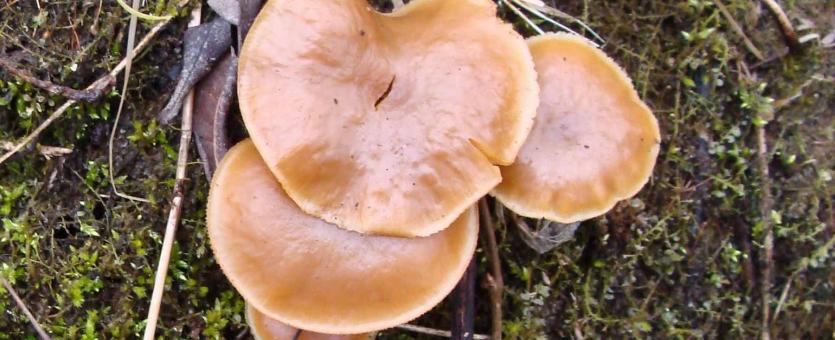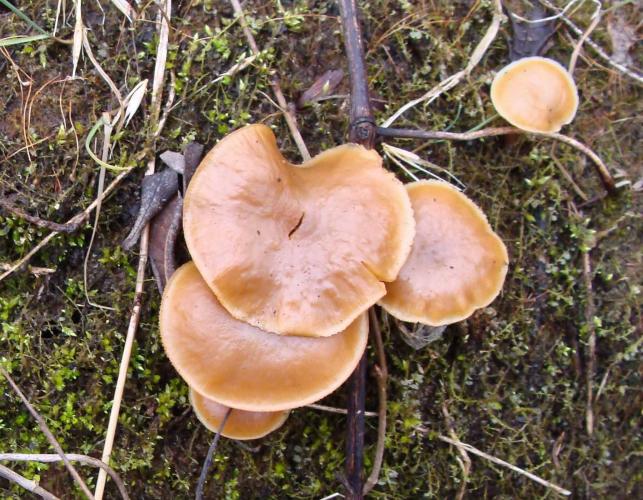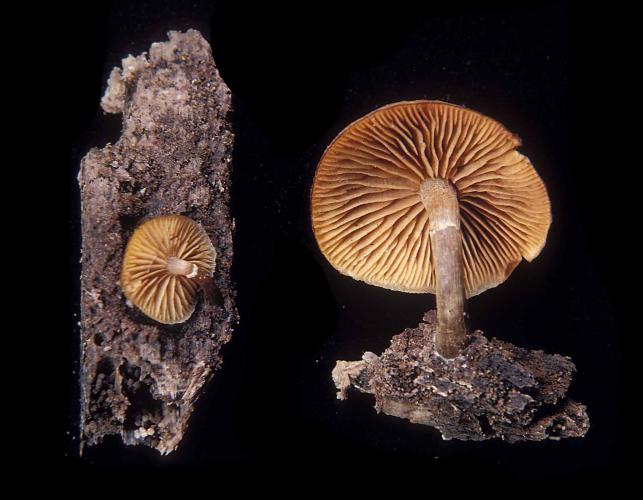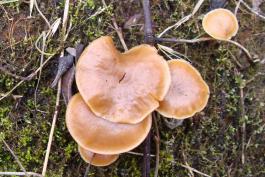
Brownish, sticky cap, yellowish to rusty gills, and a ring on the stalk. Grows scattered or clustered on deciduous and coniferous logs. Year round, but especially September–November. Cap convex, becoming flatter; dark brown to tawny ochre, fading lighter; texture sticky, smooth. Gills broad; yellowish, becoming rusty; spacing close; gills attached. Stalk enlarging downward; off-white above, brownish black below; texture smooth or finely shaggy; hollow, with a ring. Partial veil white, leaving a ring on upper stalk. Spore print rusty. Spores magnified are elliptical, roughened, with slight depression.
Lookalikes: The velvet foot (Flammulina velutipes) does not have a ring and has white spores. The honey mushroom (Armillaria mellea) and ringless honey mushroom (Desarmillaria caespitosa) have white spores.
Cap width: 1–2½ inches; stalk length: 1–4 inches; stalk width: ⅛–¼ inch.

Statewide.
Habitat and Conservation
Grows scattered or clustered on deciduous and coniferous logs. When growing from buried wood, it can look like it's growing from soil. As with human paternity testing, scientists have been using the newly available tool of DNA sequencing to study the relatedness of mushrooms. This mushroom, along with several other galerinas, were until recently all classified as separate species. Now they are all considered the same species.
Status
DEADLY. Symptoms can begin 10 or more hours after eating. The first symptoms are vomiting, diarrhea, and cramps; these may subside for a while, but later kidney or liver dysfunction can occur, and possibly death. This is a very poisonous and common mushroom in the LBM ("little brown mushroom") category. Don’t eat LBMs!
Life Cycle
Mushrooms exist most of the time underground or within rotting logs as a network of cells (mycelium) connected to tree roots, rotting material, and/or the soil. When ready to reproduce, the mycelium develops the mushroom—this is the reproductive structure. Spores are produced in these structures and are released to begin new mycelia elsewhere. The mycelium of a mushroom can live for decades.
Human Connections
It is human nature to detest and fear things that can harm us. But remember that the fearsome chemicals of this fungus don't hurt us unless we eat them. Meanwhile, this mushroom can break down wood — an unglamorous but vital role in the ecosystem.
Ecosystem Connections
This is one of the many fungus species that live on decaying wood. It and other such saprotrophic fungi play an incredibly important role in breaking down the tough materials wood is made of and returning those nutrients to the soil.




Mushrooms are a lot like plants, but they lack chlorophyll and have to take nutrients from other materials. Mushrooms are neither plants nor animals. They are in a different kingdom — the fungi. Fungi include the familiar mushroom-forming species, plus the yeasts, molds, smuts, and rusts.
Always be cautious when eating edible mushrooms. Be absolutely sure of the ID, and only eat a small amount the first time you try it to avoid a reaction..





















